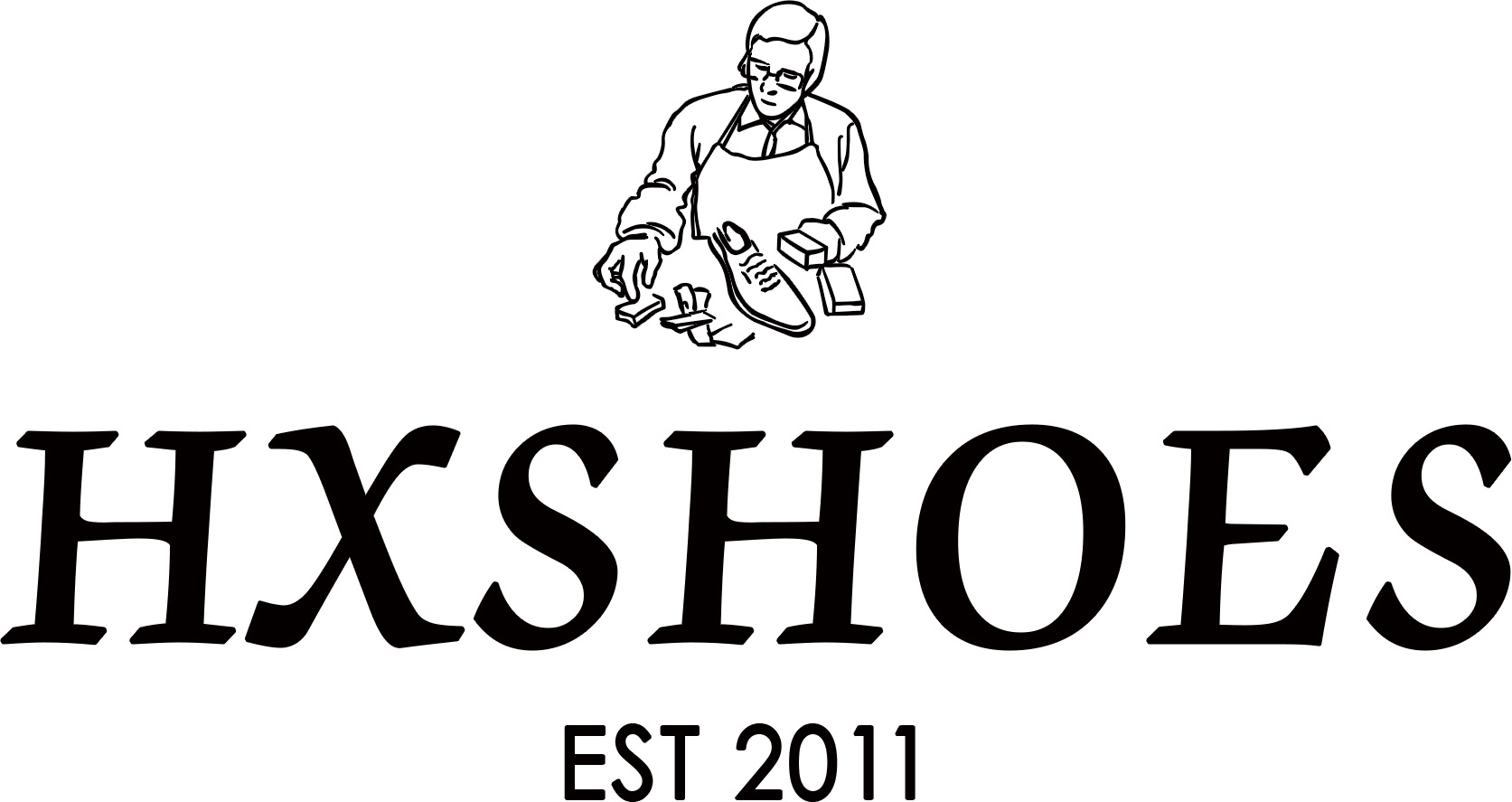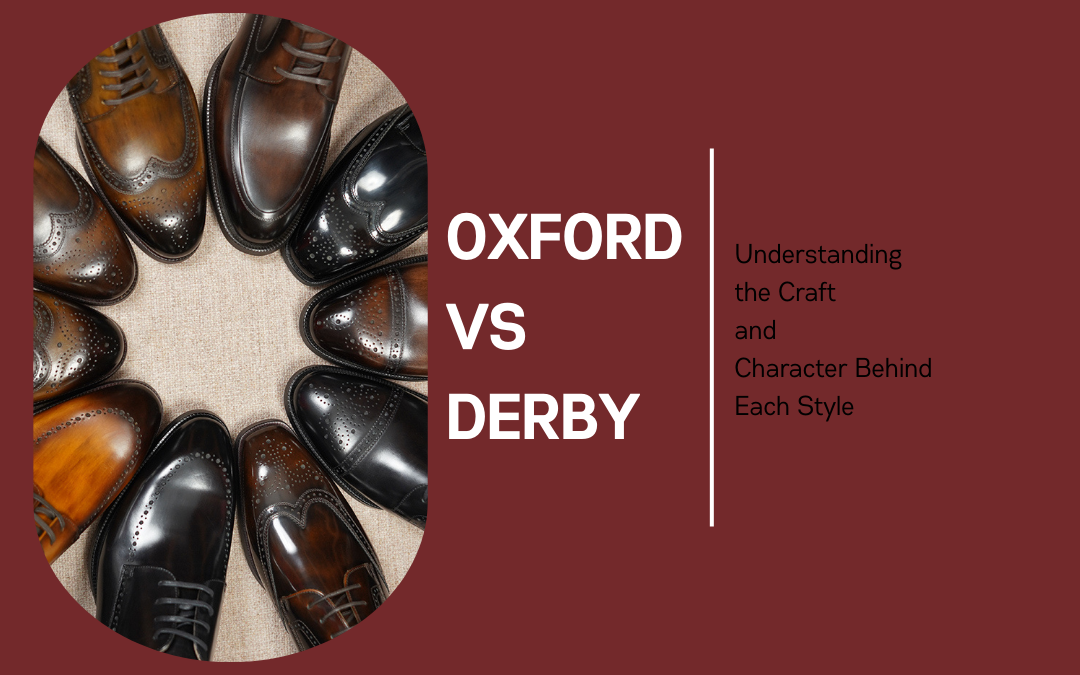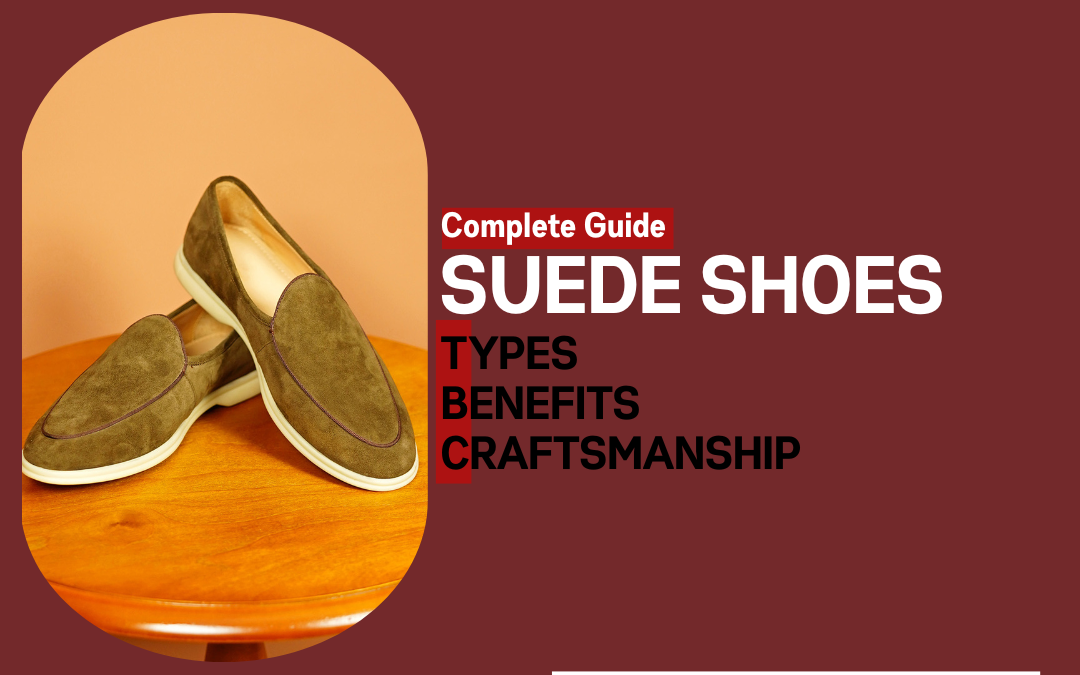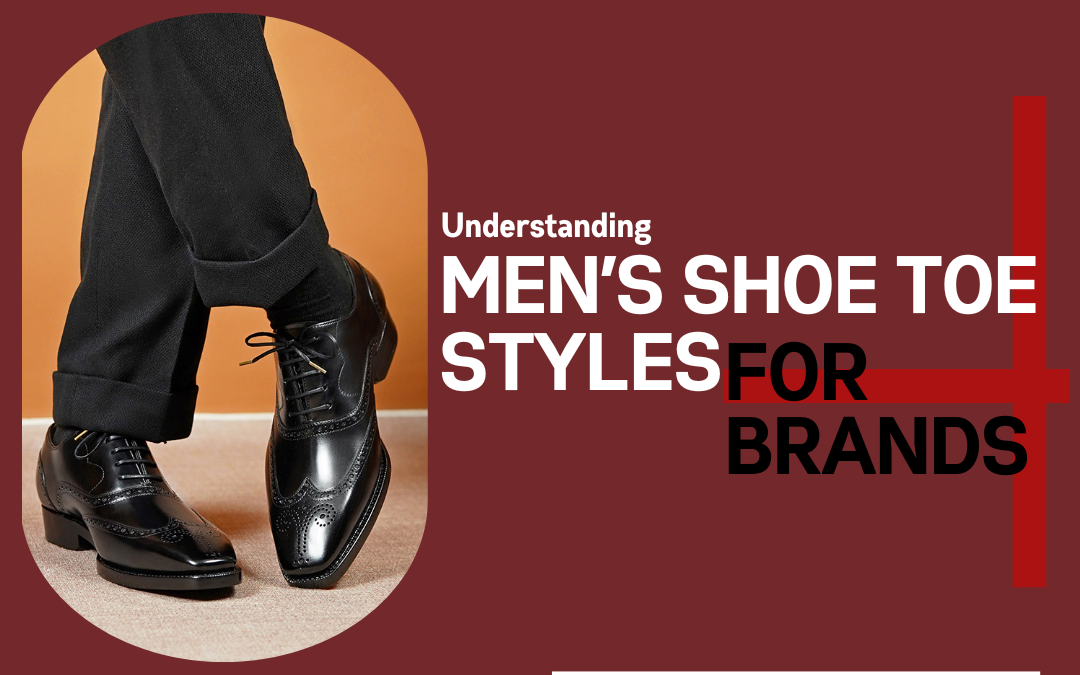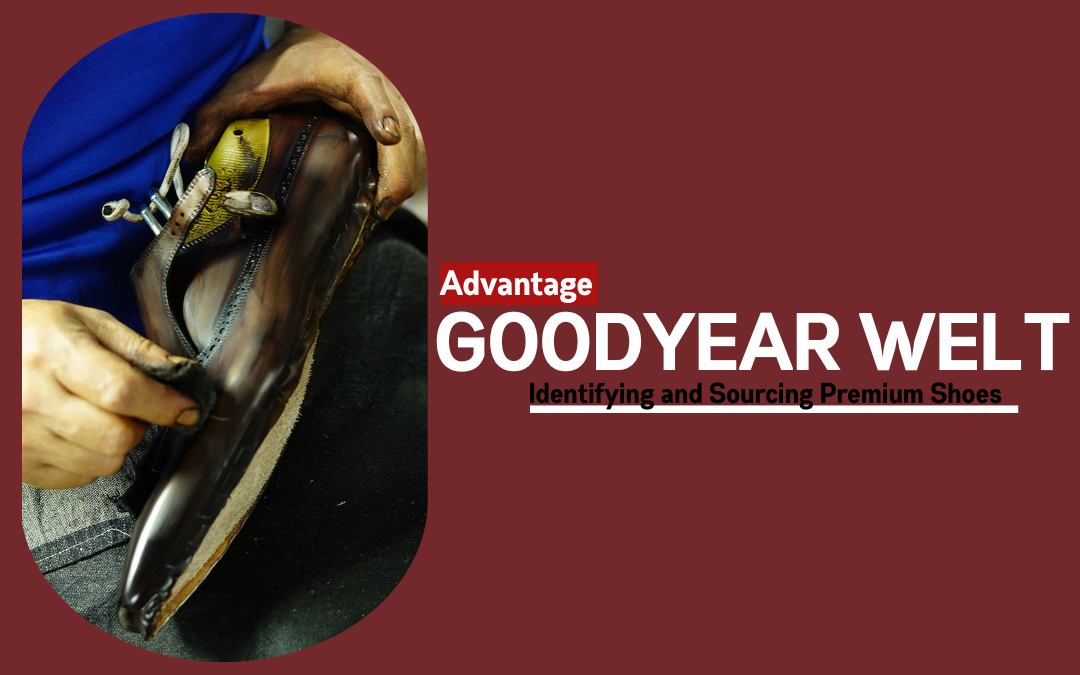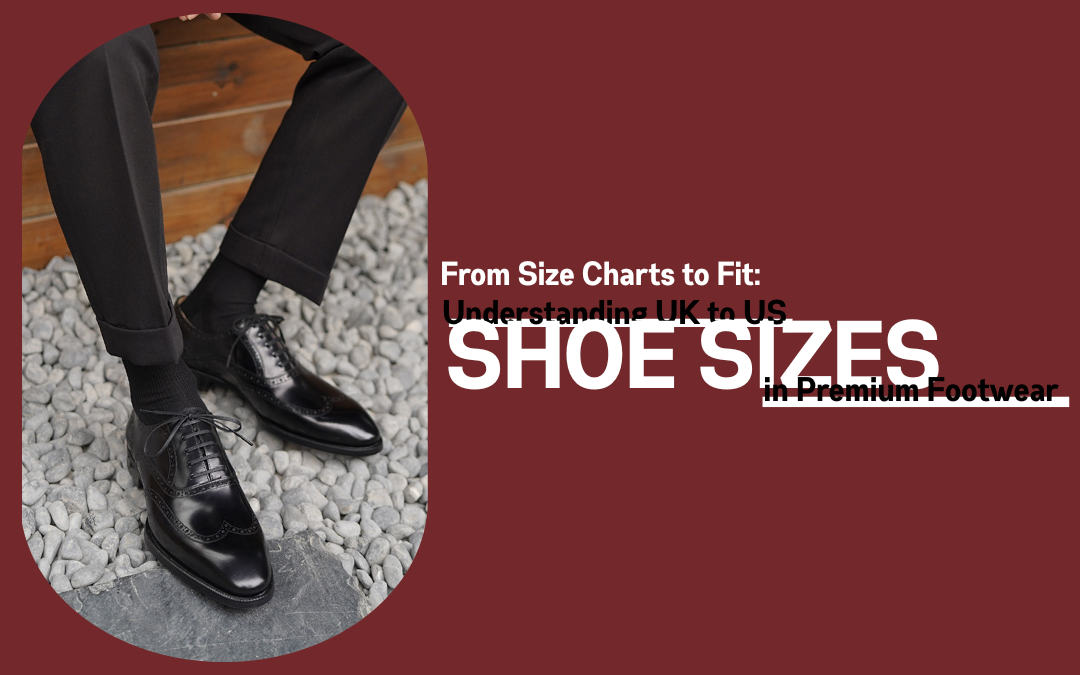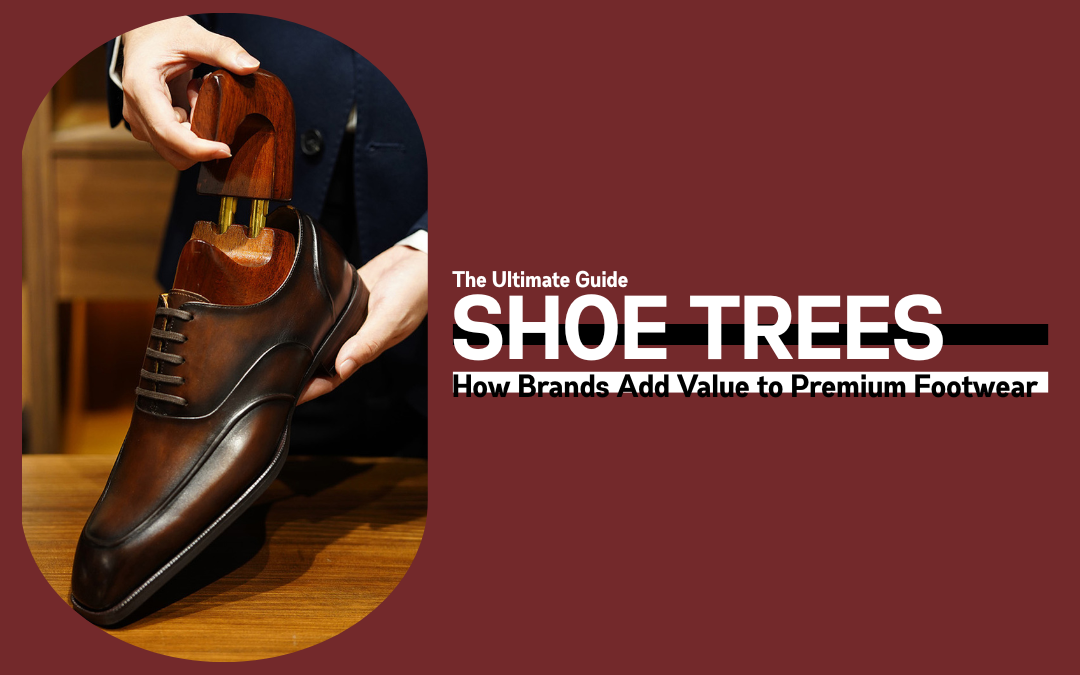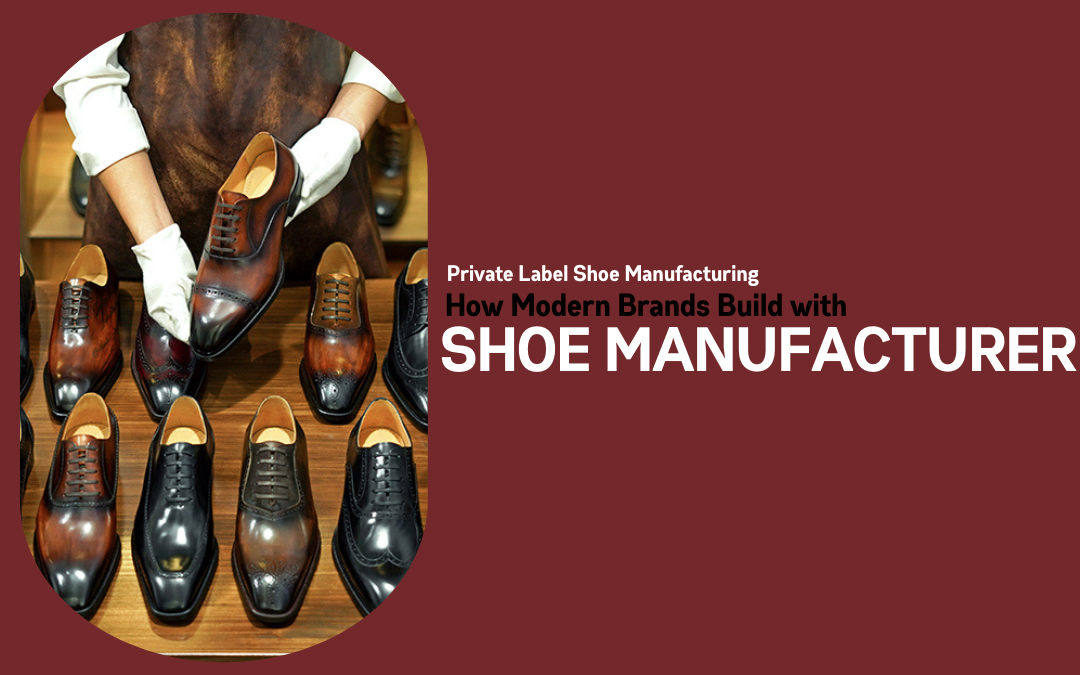Men lacing up their dress shoes are not just completing their outfit-they have a purpose in mind. The way shoes define the wearer in formal settings is a powerful non-verbal indicator of one’s respect for tradition and nuances. A gentleman’s wardrobe will house both an Oxford and a Derby formal footwear. Switching between them based on specific events, the level of formality, and the personal statement he wishes to make. This subtle but significant decision is a masterclass in dressing with intent.
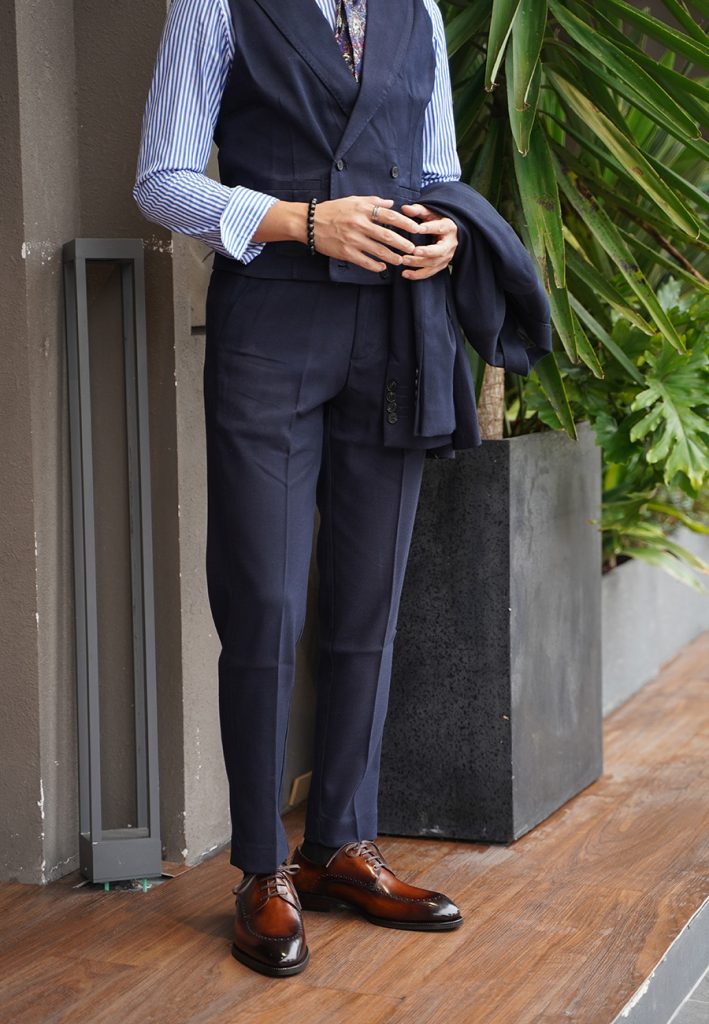
In the world of meticulously designed leather-based dress shoes, Oxford and Derby are the two fundamental designs. While they share standard features, such as a premium Goodyear welt construction, they differ significantly in their craft and character, which in turn impacts their formality. At Hengxin, we respect each shoe type, preserving its identity and purpose. This blog will cover the core difference between the shoes, explain how they impact formality, and share other construction details that add personality to the shoe.
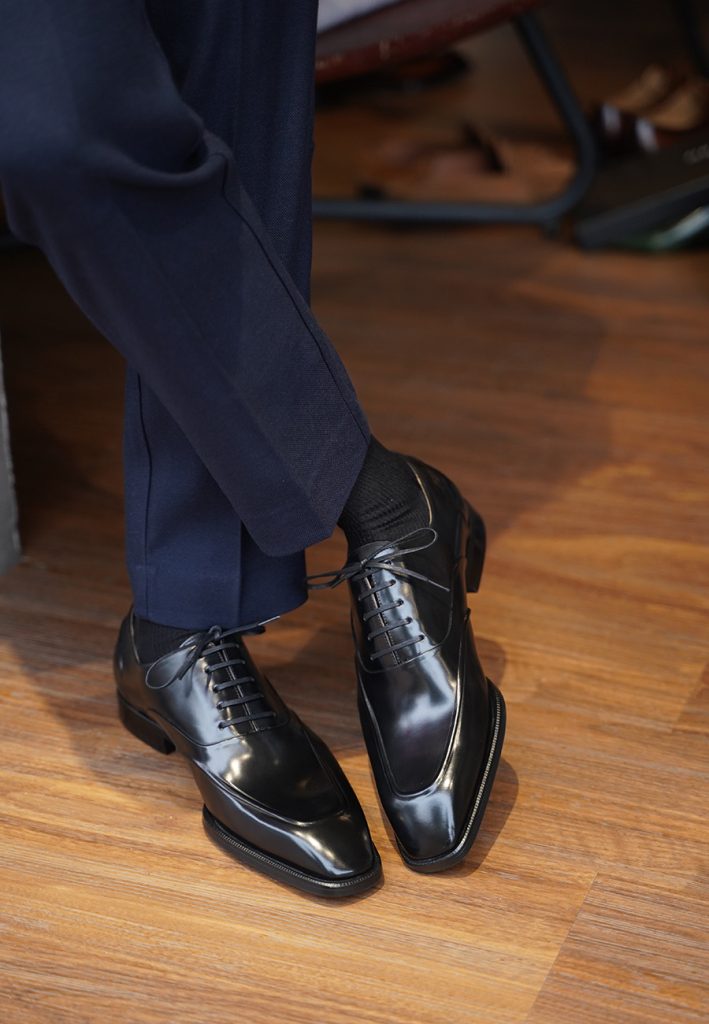
The Core Structural Difference: Lacing Systems
A skilled craftsman puts together more than 10 components to form a dress shoe. The method depends on the type of shoe and its design. Oxford and Derby dress shoes designs also have distinct build differences that a skilled craftsman meticulously executes. These differences are immediately recognizable by men with taste. Here is an explanation of the dissimilarities:
Closed Lacing (Oxford)
The Oxford dress shoe design is like the flush-fitting doors of a sports car. They are sleek and create a seamless surface that speaks sophistication. They are also tight-fitting, which means there is little margin for flexibility. Oxford shoes are the same.
An Oxford shoe has eyelets sewn under the vamp. The facing has eyelets on both sides with flaps that are tucked away underneath. The flaps are closed at the end, creating a sleek, single-piece look that’s clean and elegant. From the toe box, the closed lacing system (Oxford design) exhibits the signature “V” shape at the facing. We will explain the impact of the design on style in the later section. Let’s understand open lacing first!
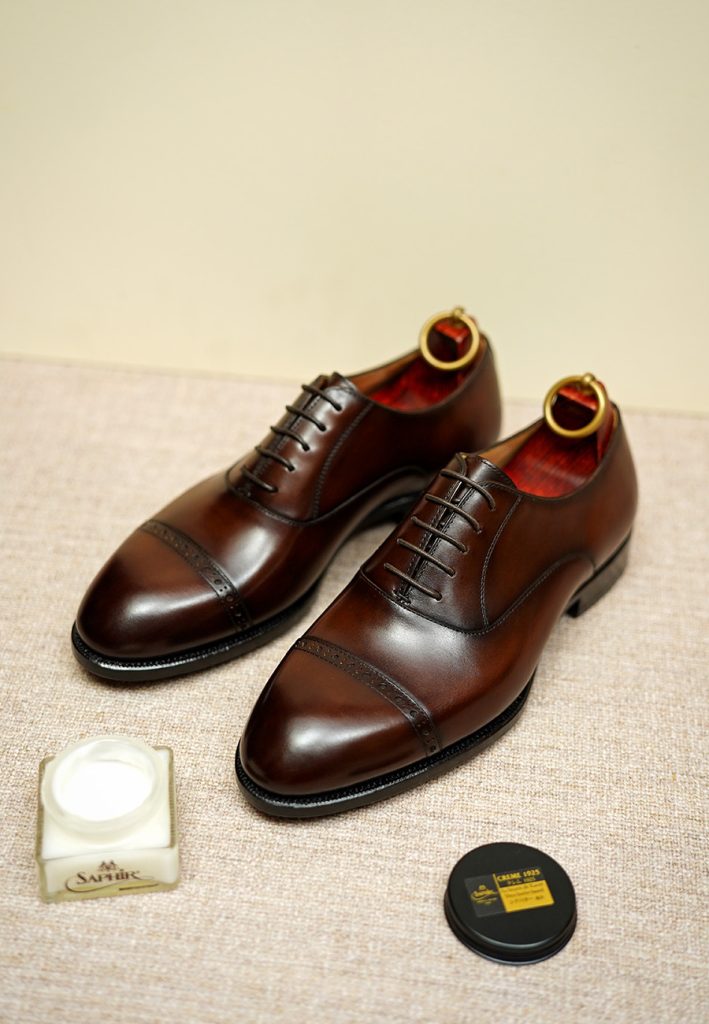
Open Lacing (Derby)
The Derby-style dress shoe offers much more flexibility. Consider a family car door that has visible doors with clearly separate panels. The design allows family car doors more versatility and higher forces during operation. Derby shoes fit the analogy.
The flaps on the Derby shoe design are visible as the quarters are sewn on top of the vamp. The eyelets are integrated onto the flaps, giving the shoes a less formal look. The use of flaps offers more flexibility, and the visible straps give it a casual character. The fit is more relaxed and adjustable depending on the user’s foot size.

Comparing Oxford Vs. Derby Dress Shoes
| Feature | Oxford Shoes | Derby Shoes |
| Lacing System | Closed lacing (eyelet tabs stitched under the vamp) → Sleek & formal | Open lacing (eyelet tabs sewn on top of vamp) → Flexible & less formal |
| Comfort & Fit | Less adjustable → not ideal for wide feet or high insteps | More adjustable → better for wide feet or high insteps |
| Versatility | Limited to formal and business dress codes | More versatile – works for formal, smart-casual, and daily wear |
| Break-in | Can feel stiff at first, especially with quality leather | Easier to wear out of the box |
Style & Formality: When to Wear Which
For men of style, ensuring that their shoes go with their outfit is of utmost importance. The two shoes lie on different scales of the formality spectrum. Footwear speaks before any words are exchanged. Arriving at an occasion with incompatible shoes can be embarrassing. To fit in your attire flawlessly, here are some tips on when to wear which style of shoes:
❖ Oxfords: The Formal Standard
The formality of Oxford shoes goes back in history, where they were staple wear for academia, high society, and professional attire. Moving to the 19th century, these shoes became the standard for business, evening wear, and ceremonial use. The change reinforces the idea of their use in black tie, business suits, and wedding event suitability. Their ability to adapt without compromising on formality makes them a trustworthy choice. Here is the list of events for which oxfords are ideal:
- Formal & Ceremonial Events
- White-Tie Events
- Black-Tie Events
- Weddings
- Graduation Ceremonies
- Funerals and Memorial Services
- Professional & Business Settings
- Job Interviews
- Board Meetings and Corporate Presentations
- Court Appearances
- Diplomatic or Government Functions
- Daily Business Formal Wear
- Special Social Occasions
- Opera, Theater, or Ballet Premieres
- Formal Evening Dinners and Galas
- Award Ceremonies
- Cocktail Parties with a Formal Dress Code
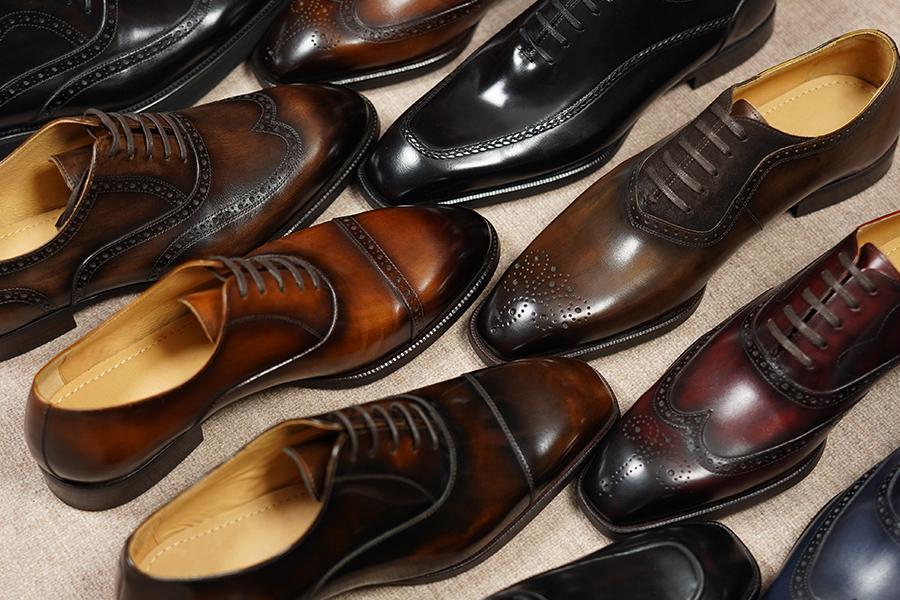
❖ Derbys: The Versatile Classic
Derbys transitioned from their initial countryside look to city wear in the mid-1800s. While initially used for hunting and sporting activities, craftsmen kept on slimming the silhouette to make it suitable for social and business settings. The visibility of quarters and eyelets is a hallmark of derbys. Derbys are commonly available in brouged suede, pebble grain, and lighter leather finishes, which naturally lean their suitability towards less formal settings. Pairing them with chinos, denim, or semi-formal tailoring highlights their adaptability outside of strict dress codes. Here are some uses for suitable conditions for Derbys:
- Business Casual Office Days
- Client Meetings in Creative/Informal Sectors
- Semi-Formal Dinners & Social Gatherings
- Smart-Casual Fridays
- Outdoor Weddings or Garden Parties
- Travel & Conferences
- Graduations or University Ceremonies
- Day-to-Day Professional Wear
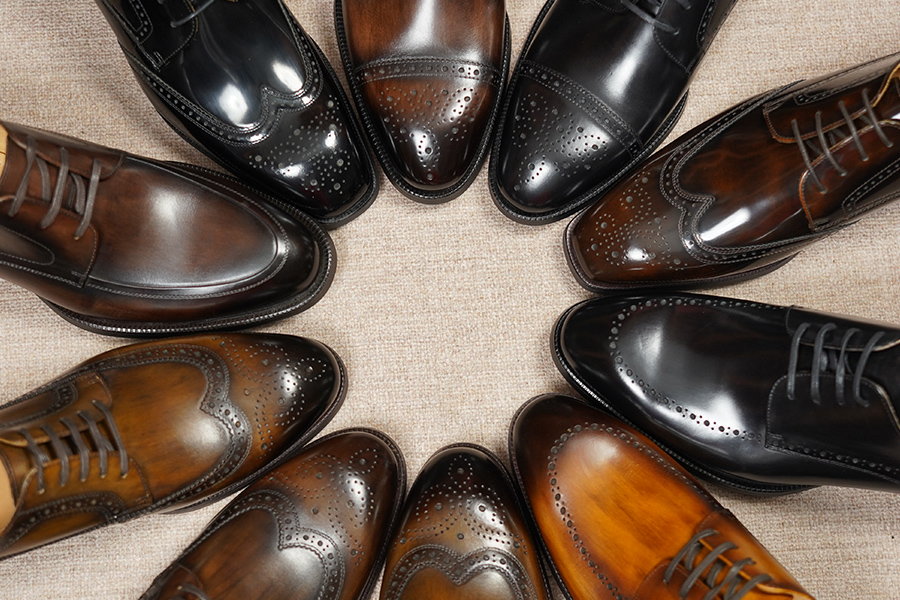
Cultural and Regional Trends
The use of Oxford or Derby dress shoes can vary depending on cultural and regional trends. We can divide trends into three regions for simplification:
- Europe: Oxford shoes are strictly for formal use, with black Oxford shoes being the standard. Derbys are valued for practicality and easy fit.
- U.S.: Corporate and black-tie events strictly use Oxfords. Whereas, Derbys are paired with Chinos/Jeans
- Asia & Middle East: Western suits are always paired with Oxfords, and Derbys are popular in fashion-forward styles (Japan/Korea) and offices (India).
Construction, Detailing & Personal Choice
The construction of dress shoes contains subtle details that also affect their formality and suitability for events. These subtle design changes can make Oxford less formal. Understanding them is key to a sleek outfit:
Toe Shapes and Silhouettes
The use of an additional leather piece on the toe box can add character to the shoe. Moreover, the open or closed lacing can directly affect its silhouette. Here are some toe shapes for both dress shoe styles:
- Cap-Toe: A leather panel is attached over the toe box, signaling elegance in Oxfords. For Derbys, the cap-toe can have excessive brogueing, making them casual.
- Plain Toe: The design is more common in Oxfords for its minimalist look.
- Wingtip (Brogue): Use of “W” or “M” shape across the toe adds flair to the shoe. It is commonly associated with countryside or weekend wear.
- Split Toe: A seam runs through the vamp to the tip of the toe—common in Derby, mainly Norwegian or casual variants.
- Medallion: These toe shapes feature a decorative design (brogued or perforated). A simple design medallion is acceptable in formal settings, while they can also be highly decorative, only suitable for casual wear.
Leather Options and Finishes
Changing the type of leather can completely change the feel and application of a dress shoe. Textures, tones, and finishes can change based on material and polish finishes. Here are some of the popular leathers used to produce dress shoes while adding craft and character to them:
- Full-Grain Leather: These are considered the highest quality, with leather that retains its entire grain layer. Their use in premium Oxford and Derby shoes is everyday.
- Patent Leather: A glossy, mirror-like finish distinguishes patent leather black oxfords from all other materials.
- Suede: It is a soft, velvety-textured leather that is more common in casual Derby shoes. However, it requires more maintenance.
- Nubuck: Similar to suede, but instead of being created from the underside, it is created from the outer side of a hide. It is sanded to a finer texture and offers more durability than suede.
The Hengxin’s collection includes multiple textures across both forms of dress shoes. Their skilled craftsman with a strong sense of material pairing create the delicate balance that differentiates the two forms eloquently. The highlighted leather options include Calfskin, suede, and museum leather.
- Calfskin: Smooth, fine-grained, and highly polished, calfskin is the classic choice for formal Oxfords, while also lending versatility to Derbies.
- Suede: Casual and soft, suede gives Derby shoes a relaxed sophistication but is rarely used in Oxfords. An Oxford with suede material is generally less formal.
- Museum Leather: Known for its hand-finished marbled patina, museum leather elevates Oxfords with depth and character, while lending Derbies a refined edge suitable for business wear.
Which One Is Right for You?
Selecting the correct form of dress shoes for you can be challenging. Therefore, consider this short step-by-step guide to find the perfect match for your application:
- Step 1: Question yourself. What is your lifestyle?
Is it corporate, social, creative, luxury, or ceremonial? In case it’s corporate, then you know that there is no better choice than Oxfords. For a casual occasion that involves creativity, Derby will hit the spot.
- Step 2: Take a Look at Your Wardrobe
Search out what speaks out when you open up your wardrobe. Are you all in suits and shirts? Or is your wardrobe filled with chinos and trousers? The degree of formal or casual dressing in your wardrobe should determine the choice between Oxford and Derby.
- Step 3: Consider the Occasion
Even if you live a casual life, there will always be times when you need an Oxford to make an impression. For example, Oxford is the gold standard when it comes to tuxedos and suits. In comparison, Derbys are ideal for situations where you need a formal but not overly so.
Conclusion: No Winner, Just the Right Choice
By now, you may be aware that there is no all-rounder when it comes to picking between Oxford and Derby form shoes. Selecting the ideal shoe for your lifestyle, wardrobe, and occasion requires extensive knowledge of when and why to use a particular form. Oxford and Derby shoes both deserve a place in a modern wardrobe. Knowing which style helps you make a smarter choice and convey a sense of purpose and self-assurance to the onlookers.
Whichever you choose, a well-made pair – like those from Hengxin will speak louder than words. Their impeccable style, comfort, durability, and build quality will surely turn heads. The attention to detail in Hengxin dress shoes, such as silhouette and use of leather, makes them a premium choice. Visit the Hengxin website to explore their vast collection of Oxford and Derby offering formality of all grades between 1-10.
FAQ
- Which is more formal — Oxford or Derby?
The more formal choice is the Oxford dress shoes. They offer a sleeker silhouette with a minimalist design and a closed lacing system that exhibits sophistication. These usually feature less brogueing. In comparison, Derby is considered a versatile, semi-formal shoe.
- Can I wear Oxford shoes casually?
Oxford shoes made from materials like suede are considered less formal or casual. Pairing them with chinos, tailored trousers, or dark jeans gives a smart-casual look. Brown or oxblood shades with shine can give them the casual look you might be looking for.
- What kind of pants go best with Derby shoes?
Depending on the degree of formality, you can wear formal trousers, chinos, or jeans with Derby shoes. They are a great pair with suits for a sophisticated look, whereas their use with jeans can give a smart-casual look. Overall, Derby shoes will give your look a less formal edge.
- Which style is more versatile for daily wear?
Derby shoes offer versatility for daily wear. Their open lacing design allows more room for movement, making them easier to pair with a variety of outfits. Derby shoes are suitable for both formal and less formal occasions. These shoes are more adaptable to everyday lifestyles.
- Can both styles be Goodyear welted?
Yes, Goodyear welting is the process of attaching a welt to the upper. The shoe can have an open (Derby) or closed (Oxford) lacing system. It doesn’t affect the Goodyear welting method or finish. Goodyear-welted shoes are durable and premium, available in both forms.
